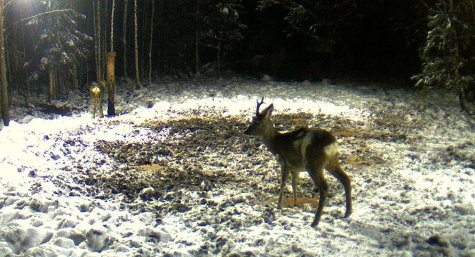Unihorn and the other roe deer
Screencap: Cax, LK forum
Translation: Liis
Roe deer Metskits ehk kaber Capreolus capreolus
The ones that differ from others are always talked about.
The bucks shed their antlers from October onwards and the last ones drop their pride in the forest just before Christmas. The buck in the webcam image is at least four years old, with three well developed tines in the antler. Mature bucks will not develop more tines over the years, only the pedicle and the coronet at the base of the antlers change. Of the six or seven animals seen on the feeding ground one buck is without antlers but its gender sign, the tassel, is visible between the legs.
In winter the bucks are more social, joining flocks of does and young animals. It is easier to get food and to scrape snow off the sleeping area together. Deer sleep on the ground because those who lie on snow catch pneumonia or enteritis and there are no doctors on call for treatment.
To distinguish between bucks and does pay attention to the white or yellowish rump patch that is larger on the does but it is no definite rule. In case of danger the rump patch hairs bristle, a clear danger signal for the others in the herd.
In camera view the deer behave nicely and peacefully, carefully checking what happens in the surroundings by listening – the ears move as locators. The Ilmatsalu hunters have not hunted roe deer in the last two severe winters and no hunt is planned this year either.









